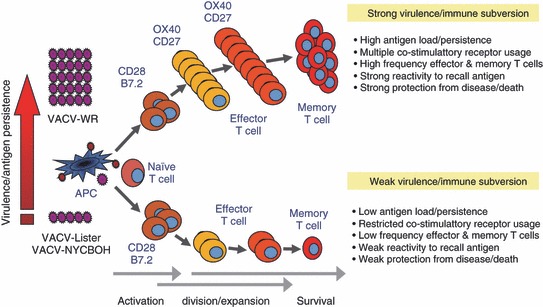Figure 3.

TNFR family members OX40 and CD27 link viral virulence to protective T‐cell vaccines. The model explains why the strongly replicating (live) vaccinia virus (VACV) Western Resrve strain (VACV‐WR) results in better CD8+ T‐cell immunity as compared with attenuated VACV strains (VACV‐Lister or VACV‐NYCBOH). The level of virus replication, brought about by virulence and immune evasion tactics, can lead to differential use by a CD8+ T cell of stimulatory receptors in the TNFR and Ig superfamilies, and that this dictates the magnitude of the T‐cell response. Two TNFR family members, OX40 and CD27, drive the generation of memory CD8+ T cells with virus that replicates strongly, or when higher doses of attenuated virus are used for inoculation. In contrast, CD28/B7 interactions, but not OX40/OX40L or CD27/CD70 interactions, are used to generate memory responses to attenuated viruses that are rapidly cleared, and this corresponds with strongly reduced T‐cell memory. This differential molecular use and altered CD8+ T‐cell memory determines the ability of the host to protect against subsequent respiratory infection.
